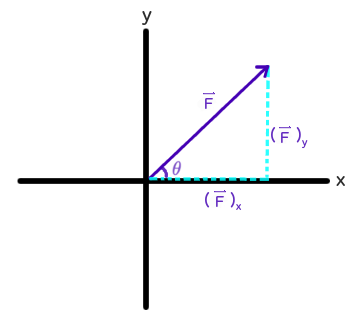What is the component of a force of 200 N at a direction 60° to the force?
1 Answer
The parallel component is
Explanation:
The force has both a parallel and perpendicular component. We can see that more clearly if we look at the force vector,

The force has been broken down into its parallel (
#x# , horizontal) and perpendicular (#y# , vertical) components.
We see that this forms a right triangle, and in this case, with an angle of
By basic trigonometry, we know that the sine of an angle of a right triangle is found by the ratio of the length of the opposite side to the length of the hypotenuse. In this case, the opposite side is
#sin(theta)=(vecF_y)/(vecF)#
We can rearrange to solve for
#vecF_y=vecFsin(theta)#
Similarly, we know that the cosine of the angle is found by the ratio of the length of the adjacent side to the length of the hypotenuse.
#cos(theta)=(vecF_x)/vecF#
We can rearrange to solve for
#vecF_x=vecFcos(theta)#
Using our known values,
#vecF_y=200*sin(60^o)=100sqrt(3)N# (#~~173N# )
#vecF_x=200*cos(60^o)=100N#
You can also check your answer using the Pythagorean theorem:
#(vecF_x)^2+(vecF_y)^2=(vecF)^2#
#sqrt((vecF_x)^2+(vecF_y)^2)=vecF#
#sqrt((100)^2+(100sqrt(3))^2)=200#
#sqrt(40000)=200#
#200=200#

